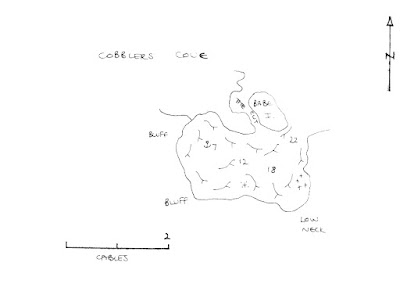Tuesday, 23 July 2024
COOPER SOUND
COOPER BAY
WIRIK BAY
54o45'S 35o51'W
Chart 3597, South Georgia
Two miles NW of Cape Vahsel is a small bay, giving good shelter from the sea from all directions but the NE.
The bay is identified from the tussac-covered island in the middle and is about 1 mile SE of a conspicuous tussac-topped island, standing a short way off the coast.
There is an above-water rock N of the SE entrance to the bay. Pass between this rock and the E side of the island in the bay.
Anchor at the head of the bay, S of the kelp that extends from the island to the shore in about 9m, good holding.
Spread along the beach at the head of the bay are the bones of a large whale, possibly a Blue or Fin and next to one piece of backbone is a rusty harpoon head.
WIRIK BAY, LOOKING NE
Saturday, 20 July 2024
GOLD HARBOUR
BJORNSTADT BAY
54o35'S 35o55'W
Chart 3597, South Georgia
We sailed in to look at this bay, N of Gold Harbour. The head of the bay has a beach, but off it the kelp was very thick, with only some small holes in it.
It would be possible to anchor in these holes in a depth of 12m. Close inshore, several drying rocks were observed.
There is another cove to the W, but this also had large quantities of kelp.
Wednesday, 17 July 2024
MOLTKE HARBOUR
HARCOURT ISLAND AND PASSAGE
ST ANDREW'S BAY
Sunday, 14 July 2024
OCEAN HARBOUR
This well-protected harbour is the site of an old whaling station, that was closed down in 1920, when it was amalgamated with Stromness. Not much of the buildings remain, but there is a narrow-gauge steam locomotive, lying on its side to the N of the site
The remains of a light structure can be seen on the bluff.
Friday, 12 July 2024
COBBLER COVE
The entrance is
straightforward and by taking a sweep to the S, once past the narrows, most of
the kelp is avoided.
Anchor off the beach at the
W end, in 6.5m, in a patch clear of kelp.
GODTHUL
54o17'S 36o17'W Chart 3589, Godthul
Godthul was another harbour
used by the whalers, but here there was a factory ship and the whales were
flensed, while they were still floating, from Jolle boats. Artifacts from these days can still be seen
ashore; there are, for example, a couple of tanks, the remains of a shed, a
heap of oak and steel barrels, three Jolle boats and several dinghies. The beach is strewn with whale bones.
The ruins are in the SE corner of the bay and, tucked in here, there is complete protection from the sea. However, there is a 1 mile fetch with winds from the N or NW. Anchor in a patch clear of kelp, off the shed, in about 6.5m.































